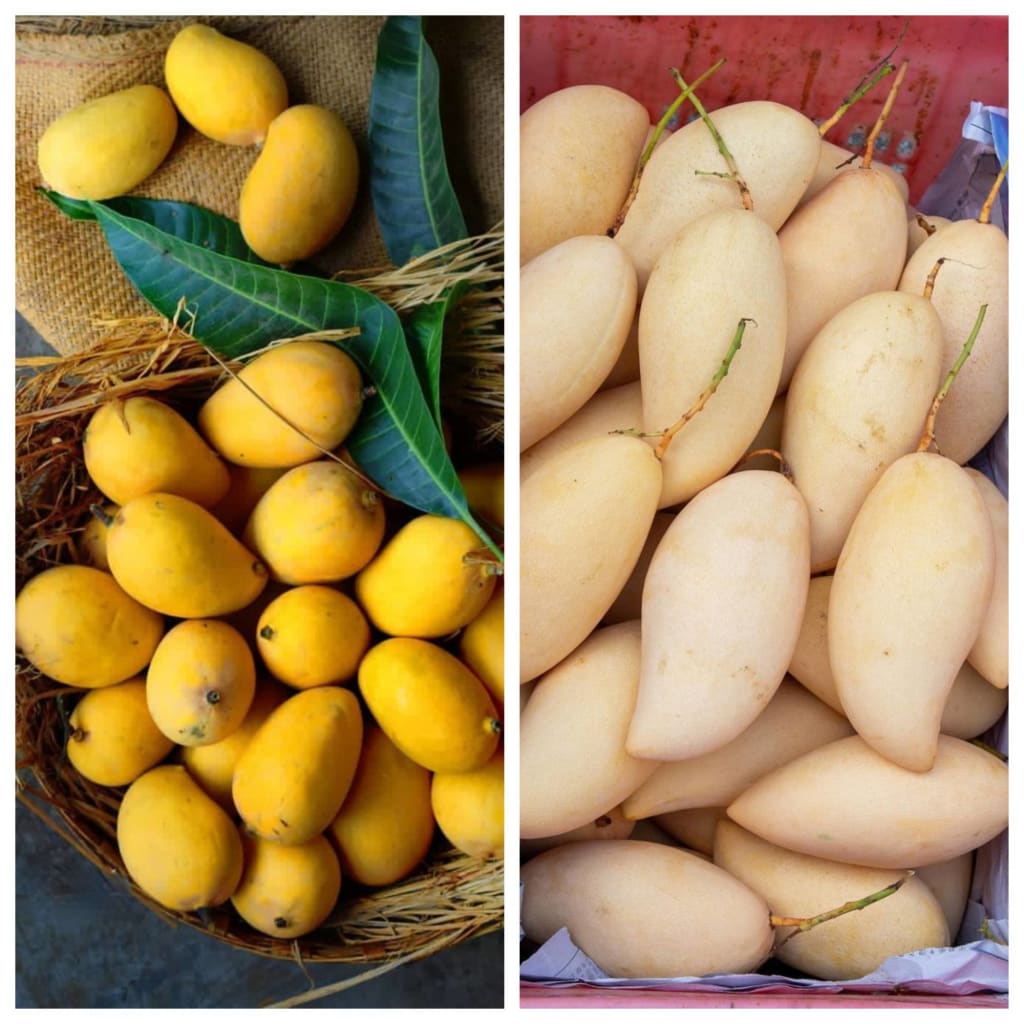The Marvelous World of Mangoes: A Delectable Journey into Nature's Sweetest Fruit
The King of the Fruit

The Marvelous World of Mangoes: A Delectable Journey into Nature's Sweetest Fruit
Introduction:
Mangoes are a tropical delight that has captured the hearts and taste buds of people worldwide. Known as the "king of fruits," mangoes are not only irresistibly delicious but also packed with numerous health benefits. In this article, we will embark on a flavorful journey, exploring the different varieties, nutritional value, cultivation practices, and exciting culinary uses of mangoes. So sit back, relax, and indulge in the marvels of this luscious fruit!
Table of Contents:
1. The Origins of Mangoes: A Tropical Legacy
2. A Plethora of Mango Varieties: From Alphonso to Tommy Atkins
3. Nutritional Powerhouse: The Health Benefits of Mangoes
4. Mangoes in Cultures and Traditions: A Symbol of Abundance and Happiness
5. Cultivation and Harvesting: Nurturing Mango Orchards
6. Mangoes on the Global Stage: Leading Producers and Exporters
7. The Art of Selecting Ripe Mangoes: Tips for the Perfect Pick
8. Mangoes in the Kitchen: From Sweet Treats to Savory Delights
9. Mangoes and Wellness: Integrating Mangoes into a Healthy Lifestyle
10. Types of Mangoes
11. The Future of Mangoes: Sustainable Practices and Innovations
12. Conclusion: Embracing the Sweetness of Mangoes
1. The Origins of Mangoes: A Tropical Legacy
Mangoes have a rich historical legacy, with their origins traced back to South Asia around 4,000 years ago. The fruit's cultivation then spread to other parts of the world through trade routes and exploration. Today, mangoes are grown in tropical and subtropical regions globally, thriving in climates with warm temperatures and abundant sunlight.
2. A Plethora of Mango Varieties: From Alphonso to Tommy Atkins
The world of mangoes encompasses a vast array of varieties, each with its unique flavor profile, texture, and appearance. From the globally renowned Alphonso mango, known for its sweet and creamy flesh, to the vibrant and tangy Tommy Atkins, there is a mango to suit every palate. Other popular varieties include the Haden, Kent, Ataulfo, and Keitt, offering a diverse range of tastes and textures to explore.
3. Nutritional Powerhouse: The Health Benefits of Mangoes
Beyond their delightful taste, mangoes offer a treasure trove of nutritional benefits. Rich in vitamins A, C, and E, mangoes support immune health, promote healthy skin, and act as potent antioxidants. They also provide a significant source of dietary fiber, aiding digestion and promoting a healthy gut. Additionally, mangoes contain an array of essential minerals like potassium and magnesium, which contribute to overall well-being.
4. Mangoes in Cultures and Traditions: A Symbol of Abundance and Happiness
Throughout history, mangoes have played a prominent role in various cultures and traditions. In many countries, mangoes are regarded as a symbol of abundance, prosperity, and happiness. They are incorporated into religious rituals, celebrated during festivals, and cherished as gifts of goodwill. The cultural significance of mangoes further enhances their allure and the sense of joy they bring.
5. Cultivation and Harvesting: Nurturing Mango Orchards
Growing mangoes requires meticulous care and attention. Mango orchards thrive in well-drained soil, ample sunlight, and regular watering. The cultivation process involves grafting and pruning to ensure healthy tree growth and abundant fruit production. Harvesting is a delicate task, as mangoes need to be picked at the optimal stage of ripeness to maximize their flavor and shelf life.
6. Mangoes on the Global Stage: Leading Producers and Exporters
Mangoes are widely cultivated across the globe, with several countries serving as major producers and exporters. India, the largest producer of mangoes, boasts a diverse range of indigenous varieties. Other significant mango-growing nations include China, Thailand, Mexico, and Indonesia. The global market for mangoes continues to expand, with these countries contributing to the growing demand and availability worldwide.
7. The Art of Selecting Ripe Mangoes: Tips for the Perfect Pick
Choosing a ripe and juicy mango can be an art form in itself. Look for a slight give when gently squeezed, as firmness indicates an unripe fruit. The color and aroma are also vital indicators of ripeness. A sweet, fragrant aroma and a vibrant coloration, varying by variety, are signs of a ripe mango. By mastering the art of selection, you can enjoy the perfect mango every time.
8. Mangoes in the Kitchen: From Sweet Treats to Savory Delights
Mangoes' versatility extends beyond being enjoyed fresh. They are a beloved ingredient in various culinary creations. From tropical smoothies and vibrant fruit salads to refreshing sorbets and creamy mango lassis, the possibilities are endless. Mangoes also lend their unique flavor to savory dishes, such as tangy salsas, spicy chutneys, and exotic marinades, adding a delightful twist to your meals.
9. Mangoes and Wellness: Integrating Mangoes into a Healthy Lifestyle
Incorporating mangoes into your diet can contribute to a healthy lifestyle. With their natural sweetness, mangoes provide a satisfying alternative to processed desserts and sugary snacks. Their fiber content aids digestion and supports weight management. Whether enjoyed as a post-workout snack, a refreshing smoothie, or a colorful addition to your meals, mangoes can enhance your overall well-being.
10. Types of Mangoes
Alphonso: Known as the "King of Mangoes," Alphonso mangoes are highly prized for their rich, creamy texture, vibrant saffron-colored flesh, and sweet, aromatic flavor. They are primarily grown in India.
Tommy Atkins: This variety is one of the most widely available mangoes worldwide. Tommy Atkins mangoes have a bright red skin with green and yellow accents. The flesh is firm and slightly fibrous, with a sweet and tangy taste.
Kent: Kent mangoes have a greenish-yellow skin with a red blush. They are juicy and sweet, with minimal fiber. Kent mangoes are commonly found in the United States and Mexico.
Ataulfo: Also known as the Champagne mango or Manila mango, Ataulfo mangoes have a small, oblong shape and a vibrant yellow skin. They are incredibly sweet, smooth, and creamy in texture. Ataulfo mangoes are primarily grown in Mexico.
Haden: The Haden mango is an iconic variety and one of the first to be cultivated in Florida, United States. It features a vibrant red skin with green and yellow undertones. The flesh is juicy, fiber-free, and offers a balanced blend of sweetness and acidity.
Keitt: Keitt mangoes are large, with a smooth green skin that remains green even when fully ripe. They have a mild, sweet flavor, and their flesh is juicy and nearly fiber-free. Keitt mangoes are commonly grown in the United States, Mexico, and Israel.
Julie: Originating in the Caribbean, Julie mangoes are small to medium-sized fruits with a greenish-yellow skin. They are known for their intense sweetness, aromatic flavor, and smooth, fiberless flesh.
Valencia Pride: This variety has a bright yellow skin with red blush and green accents. Valencia Pride mangoes are large and juicy, with a rich, sweet flavor and minimal fiber. They are commonly cultivated in Florida, United States.
Keow Savoey: Keow Savoey mangoes, also known as Thai honey mangoes, have a greenish-yellow skin and a distinct elongated shape. They are exceptionally sweet, with a floral aroma and tender, fiberless flesh. Keow Savoey mangoes are predominantly grown in Thailand.
Palmer: Palmer mangoes have a vibrant red and green skin and a rounded shape. They are juicy and sweet, with a tropical flavor and minimal fiber. Palmer mangoes are primarily cultivated in Florida, United States.
These are just a few examples of the diverse range of mango varieties found across the globe. Each variety offers its own unique characteristics, making mangoes a truly delightful fruit enjoyed by people worldwide.
11. The Future of Mangoes: Sustainable Practices and Innovations
As awareness of sustainable practices grows, mango cultivation is adapting to minimize environmental impact. Organic farming methods, efficient irrigation systems, and responsible waste management are becoming more prevalent in mango orchards. Furthermore, advancements in research and technology aim to enhance mango production, ensuring a sustainable future for this beloved fruit.
12. Conclusion: Embracing the Sweetness of Mangoes
In conclusion, mangoes are a delightful fruit that tantalizes our taste buds while offering a plethora of health benefits. From their tropical origins to their widespread cultivation, mangoes have captivated people worldwide with their luscious flavors and vibrant colors. Whether enjoyed fresh, blended into delicious recipes, or revered in cultural traditions, mangoes truly hold a special place in the culinary world. So, let us savor the sweetness of mangoes and celebrate the wonders of this delectable fruit.
In this article, we embarked on a flavorful journey, exploring the different varieties, nutritional value, cultivation practices, and exciting culinary uses of mangoes. We hope you have gained a newfound appreciation for this tropical treasure and are inspired to indulge in its juicy goodness whenever the opportunity arises. Happy mango adventures!
About the Creator
Ghulam Abbas
Skilled content writer with 15 years' experience in humanities and motivation. Illuminating insights in literature, history, philosophy, and culture, connecting readers to human experiences. Expertise in motivational writing.





Comments
There are no comments for this story
Be the first to respond and start the conversation.